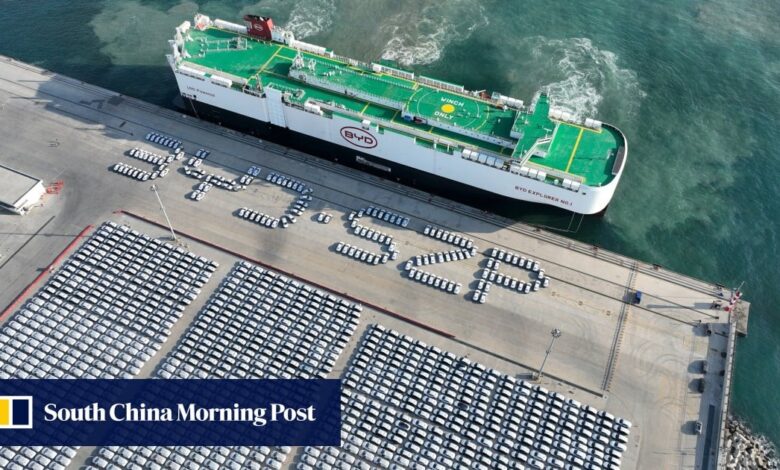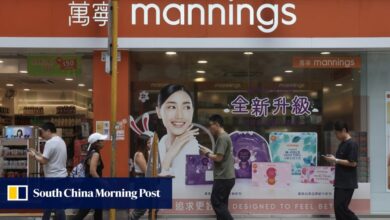China’s southern megacities dealt contrasting economic fortunes as hi-tech Shenzhen thrives

The tech hub of Shenzhen, though, revealed a glowing report card as its economy expanded by 5.9 per cent to 1.73 trillion yuan, ranking only after Shanghai and Beijing.
“The adverse effects of the current external environment shifts are increasing, domestic effective demand is insufficient and economic operation is showing differentiation,” said the readout released by the official Xinhua News Agency.
Shenzhen’s new industries and hi-tech investment are growing rapidly, but Guangzhou and Foshan still rely heavily on traditional manufacturing
Beijing has signalled its resolve to attain the around 5 per cent economic growth target for 2024.
Guangzhou residents are now anxiously discussing if the city, the capital of Guangdong, would drop out of China’s top-tier cities.
Guo Wanda, vice-president of the China Development Institute – a government-backed think tank to the Greater Bay Area – said cities faced a combination of sluggish traditional industrial growth and rapid development of new sectors.
“Shenzhen’s new industries and hi-tech investment are growing rapidly, but Guangzhou and Foshan still rely heavily on traditional manufacturing and they need to expedite transformation,” Guo said.
“Shenzhen’s private enterprises are very dynamic and technology iteration is fast.
“The industrial chains surrounding Shenzhen’s hi-tech manufacturing, like electric vehicles, are very long, driving other industries such as electronics and information.”
Guangzhou, meanwhile, is grappling with headwinds on many fronts from investment, manufacturing, consumption to foreign trade.
Its fixed-asset investment in the first half grew by just 2 per cent, 1.9 percentage points below the national average, while its industrial output fell by 0.8 per cent, its exports declined by 4.1 per cent and its retail sales growth flatlined.
Shenzhen, though, fared better as it derived strong momentum from its sprawling manufacturing sector as industrial output grew 12 per cent.
Manufacturing-related fixed-asset investment, meanwhile, soared by 49.2 per cent in the first six months of the year.
Shenzhen, which has nurtured the likes of Huawei Technologies, Tencent and BYD, unseated Shanghai as China’s largest manufacturing city in 2022.
Already China’s largest exporting city, burgeoning foreign trade also propelled Shenzhen’s growth as its import and export volume soared by 31.7 per cent year on year in the first half of the year to 2.2 trillion yuan.
And as Shenzhen charges ahead, officials in Guangzhou are reflecting on the economic woes, blaming slow industrial upgrades and insufficient demand.
Guangzhou’s automobile industry provides a microcosm of the city’s challenges as its output – which is made up of more petrol-powered cars than electric vehicles – fell by 16.4 per cent in the first half of the year as major carmakers from Toyota to Honda have slashed production in Guangzhou.
“Many people in our casual chats mentioned the news that Honda is closing factories in Guangzhou. That was a big manufacturing base for the city that we used to be proud of,” a Guangzhou taxi driver said.
Honda announced in July it would close some production lines in Guangzhou in October.
Terence Chong Tai-leung, an associate professor of economics at the Chinese University of Hong Kong, said Guangzhou had been affected by domestic demand problems, while Shenzhen was more export-oriented.
Guangzhou’s manufacturing sector is more anchored at the domestic market and is thus not immune to China’s overall weak consumption
“Shenzhen is exporting mainly hi-tech products at a time the world is buying more from China,” he said.
“Guangzhou’s manufacturing sector is more anchored at the domestic market and is thus not immune to China’s overall weak consumption.
Mounting export uncertainties may also alter the fortunes of Shenzhen and its hi-tech exports.
“The uncertainty is increasing because new trade frictions are already there.”
In May, Washington proposed increasing tariffs on imports of Chinese semiconductors, electric vehicles, steel and batteries, drawing a swift rebuke from Beijing.
Additional reporting by Alice Li
Source link




